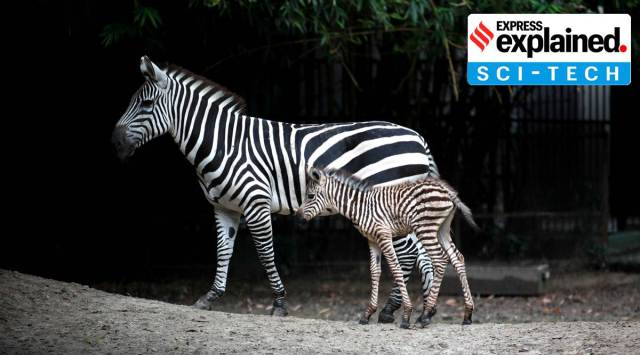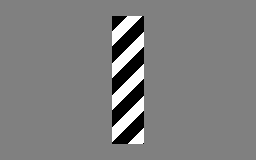Why does a zebra have stripes? Many old theories, some new findings
Do a zebra’s stripes help camouflage it from predators? Or do they help regulate body temperature, enable mutual recognition, or confuse flies that would suck their blood?
 According to one theory, According to this theory, the black and white stripes create an optical illusion for flies and other parasites that would have sucked on the zebra’s blood. At Alipore Zoo. File/Express Photo by Subham Dutta
According to one theory, According to this theory, the black and white stripes create an optical illusion for flies and other parasites that would have sucked on the zebra’s blood. At Alipore Zoo. File/Express Photo by Subham DuttaWhy does a zebra have stripes? It is a question that has intrigued generations of scientists, including Charles Darwin, and they have proposed a number of possible answers over the years.
Research into the subject continues, with the latest study published on Wednesday in the journal ‘Proceedings of the Royal Society B’. While this study looks extensively into one possible reason why a zebra has stripes — that these help confuse blood-sucking parasites — let us begin by looking at all the major ideas proposed over the years.
So, what are these ideas?
CAMOUFLAGE: One idea is that the stripes provide the zebra with camouflage from predators by creating a kind of optical illusion. The stripes on a zebra, the hypothesis goes, blends with the lines of the tall grass around it. This might not work for a human observer, for the black and white stripes would stand out against the coloured grass. But the zebra’s main predator, the lion, is colour-blind: Proponents of the camouflage hypothesis note that a lion would not be able to differentiate between zebra stripes and lines of grass. And yet, this theory has also been contested. In 2016, researchers published a study that showed that in treeless habitats, lions could see the outline of striped zebras just as easily as they could see similar-sized prey with solid-coloured hides.
TEMPERATURE REGULATION: By this theory, the stripes help a zebra keep cool in the heat. Retired amateur naturalist Alison Cobb, who has studied zebra stripes for more than 40 years, has found that the temperature of the black stripes is considerably warmer than that of the white stripes. In a study published in 2019, she and her zoologist husband Stephen Cobb proposed that these temperature differences cause air flows between the black and white stripes, which could help cool the zebras by speeding up the evaporation of sweat.
MUTUAL RECOGNITION: This is a much simpler idea. It is known that every individual zebra has a unique pattern of stripes, just like every human has a unique set of fingerprints. This hypothesis goes that the unique stripes help individual zebras recognise one another.
CONFUSING BLOODSUCKERS: This is the subject of the latest study. According to this theory, the black and white stripes create an optical illusion for flies and other parasites that would have sucked on the zebra’s blood. Essentially, because of the stripes, flies have been seen to miscalculate the moment when and speed at which they should land on the zebra.
Does the new research validate this theory?
These researchers did find evidence to back up this theory. But that was in a previous study, published in 2019. Then, they showed experimentally how flies got confused by zebra stripes. In the study published this week, they investigated the mechanism that makes this happen.
So, what did the 2019 study find about confused flies?
In the 2019 study, Dr Martin How of the University of Bristol and research colleagues investigated the behaviours of horse-flies around captive zebras and domestic horses, using video analysis techniques. From a distance, horse-flies circled both zebras and domestic horses at the same rate. However, when they approached a zebra, the horse-flies failed to slow down. Slowing down is essential for a successful landing. On horses, successful landings were found to be more frequent. But when approaching zebras, the horse-flies either flew over the stripes, or bumped into them. The takeaway: it is most likely the stripes that are confusing the horse-flies.
📣 Express Explained is now on Telegram. Click here to join our channel (@ieexplained) and stay updated with the latest
And how do zebra stripes confuse the flies?
This is what this week’s study looked at. Specifically, the researchers looked at a trick of light called the aperture effect. For a human example, consider the “barber-pole illusion”.
 In the barber-pole effect, when the pole rotates horizontally, the stripes appear to be moving upward. (Source: Wikipedia)
In the barber-pole effect, when the pole rotates horizontally, the stripes appear to be moving upward. (Source: Wikipedia)Such striped poles are hung outside barbershops in some countries. The cylindrical pole rotates horizontally, around its vertical axis. But because of the way the stripes are aligned, our brains process the movement in a way that it appears the stripes are continuously moving upward.
Is the same kind of illusion at play when a fly approaches a zebra?
Apparently not. This is what experiments by Dr How and colleagues showed. “The idea is that the stripes induce an optical illusion that confuses the visual system of the fly, convincing them that the striped object is not an object at all, so the fly carries on past without landing,” Dr How told The Indian Express, by email.
The reason the study ruled it out is that flies were confused not only by zebra stripes, but also by rugs in stripe and chequered patterns. “In our experiment, we showed that checked rug patterns were equally effective at repelling biting flies. Checked patterns do not induce the aperture effect, so this illusion cannot be responsible for the anti-biting fly effect of zebra stripes,” Dr How said.
Also in Explained: A new calculation to find out your dog’s age in human years
Then, what could be the mechanism for zebra stripes confusing flies?
“We still don’t know,” Dr How said. But he proposed two ideas.
One idea is that a different optical illusion could be at play. This is known as temporal aliasing. “A human example of this is the wagon-wheel illusion from cowboy and western films. Spokes on the wheels of the wagon make it look like the wheel is spinning at different speeds due to a mismatch between the spokes over time. Perhaps zebra stripes (and checked patterns) induce this illusion in the eyes of flies,” Dr How said.
“Another possibility is that the stripes and checks break up the object so that it no longer fits a search image that the fly needs to find a host,” he said. “We still don’t know.”






































